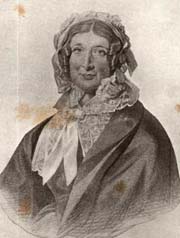 Lewes Today
Lewes Today publishes today an intriguing article about literary connections between Jane Eyre and
Seaford, East Sussex:
THE recent BBC television adaptation of the story of Jane Eyre set me thinking of its literary links with Seaford, particularly Corsica Hall.
It has long been held that the grand-daughter of one Thomas Harben, who came to Seaford from Lewes in the late 1780s , was the model for the stern woman who gave Jane such an unhappy time at Lowood. HER grandson in real life was Neville Chamberlain, Prime Minister of Great Britain at the outbreak of the Second World War. (...)
For a short time this little town was graced by the presence of one great man of letters when Alfred, Lord Tennyson lived at the old Seaford House, where it is believed he put the finishing touches to his Ode on the Death of the Duke of Wellington. Perhaps he had second thoughts after experiencing life in a place 'which stood four-square to all the winds that blew' for, quite soon after, he and his family moved to the Isle of Wight. Rumours persist that Miss Jane Austen visited Seaford while researching her last (unfinished) novel Sanditon.
Miss Scatcherd,
whose real name [Elizabeth Gaskell] w[as] merciful enough not to disclose in her
Life of Charlotte Brontë, it seems that was based on
Susan Harben (please check the
EDIT, at the end of this post):
Susan Harben, 1785-1848, "dear old aunt Sue" who did not marry and became matron of the Clergy Daughter's School at Kirkby, Lonsdale. This was the school Charlotte Bronte was sent to and, according to "Notes on the families of Chamberlain and Harben", Matron Harben was apparently the model for the Matron in "Jane Eyre". The picture [above] of Susan Harben is from "Notes on the families of Chamberlain and Harben".
The picture is courtesy of this
website.
We have some other mentions today in the press.
A couple of
newspapers review a book that we presented some weeks ago:
Visual Verse by John Parkinson that contained some Emily Brontë's poetry:
"Visual Verse" (Synergy Books, $29.95) combines some of his favorite photos with some of his favorite poems — ones he's written himself and others that he's long admired, such as William Wordsworth, Emily Bronte, Lord Alfred Tennyson, William Shakespeare, Robert Service, Joyce Kilmer and others.
The Australian writes about inspiring landscapes in North England and Top Whithens gets a mention:
For bookworms, England's North Country is a real page-turner. The three Bronte sisters -Emily, Charlotte and Anne-were born in Thornton, Bradford, and spent much of their lives in the West Yorkshire village of Haworth, where they lived with their father at the Parsonage. Their writings were heavily influenced by the surrounding Pennine moorlands, especially the area known as Top Withens, which was later famously renamed by Emily as Wuthering Heights in the book of the same name. The Parsonage is now a museum dedicated to the Bronte sisters, and is well worth a visit.
And finally, a new Brontëite is presented,
author Jay Mandal.
[M]y favourite books are Il Gattopardo, Wuthering Heights, and To Kill A Mockingbird.
EDITAt the time of publishing this post we had no access to our bibliographical sources. We have now checked the information and we are not at all sure that Mrs. Harben claim to be the original for Miss Scatcherd can be sustained:
1. W. Gérin "Charlotte Brontë. The Evolution of Genius". Chapter 1. Additional Notes.
CB remembered Miss [Ann] Evans with gratitude and regard and pictured her as "Miss Temple" in Jane Eyre. Like Miss Temple, Miss Evans left school to be married on 6 July 1826 at Tunstall Church (...) Miss Evans was succeeded as superintendent of the school by Miss -or Mrs.- Harben, a close friend of Carus Wilson. The courtesy title of "Mrs." was given her of the tragic circumstance of her bridegroom having died in church on her wedding day. Mrs. Harben remained at school until 1843.
So, as Charlotte and Emily were removed from the school on June 1, 1825, they didn't coincide with Mrs. Harben.
2. The original for Miss Scatcherd is a Miss Andrews, a teacher that had also temporarily been superintendent of the school in Juliet Barker's words (The Brontës, St Martin's Press, 1995, p. 126).
3. Rebecca Fraser also quotes in her biography on Charlotte Brontë (Vintage, 2003, p. 41), that the original Miss Scatcherd was also the writer (by the name A.H.) of one of the letters that the supporters of Carus-Wilson published around 1857 to discredit the way Charlotte Brontë had portrayed Cowan Bridge as Lowood School in Jane Eyre.
More info: Brett Harrison, 'The real "Miss Temple'' ' BST 85 (1975)
Categories: In the News, Brontëana, Jane Eyre, Brontëites, Books









0 comments:
Post a Comment